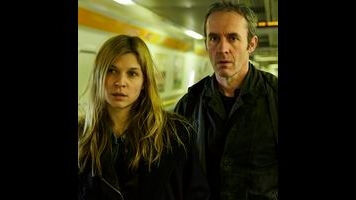The Bridge gets a British-French makeover in The Tunnel

Stop me if you’ve heard this one before.
A government official is found murdered exactly on the border between two countries. She’s bisected in half, legs in country, torso on the other (except, those legs aren’t really hers). Two very different investigators — one who is all procedure, the other who is all charm and gut instinct — must work together despite their ostensible differences to solve the case. Based on the Scandinavian show The Bridge (or Bron or Broen depending on the language), The Tunnel takes that premise and places the action in between the French and British border in the Channel Tunnel (which of course makes me think of Seinfeld). Americans got into the act for two season with FX’s The Bridge, a show that could alternate from being a brilliant police procedural about two very different cops, to a ridiculous show about a maniac that relied too heavily on twists, coincidences and thin red herrings. Many, but not all, of those bad habits came from the Swedish-Norwegian original, but so did some of its strengths, namely the killer — no pun intended — concept.
There’s a couple ways of looking at the opening episode of The Tunnel. For those that came in blind to the two shows that preceded it, as I said before, that concept is enticing. The first episode of The Tunnel does well incorporating the basic plot elements. Yet, it never feels like it has the same urgency or suspense that the two previous iterations could muster, until Tom Bateman’s Danny Hillier gets trapped in his car by a bomb that never goes off. But I’m also willing to admit that after seeing this same story play out two times already, it’s lost its luster.
Watching it for the third time, though, it becomes so apparent why The Bridge is so ripe for adaptation across different countries. It’s not just the salacious aspects of the case itself. When the shock value is gone, what’s left of the plot? The ability to juxtapose the dualities of countries and countrymen, people divided by politics and history who have evolved to have different cultures and mannerisms, remains fascinating to watch. “The British place a lot of value on humor, sometimes it makes you lose sight of things that are more important. That is just my opinion, I’m not trying to offend you,” the socially-inept, possibly Aspbergian Elise Wassermann (Clémence Poésy) says to her new de facto partner Karl Roebuck (Stephen Dillane). “Oh, sure. I’ll bring you up to speed with my assessment of French national defects later,” he replies. “I’d be interested to hear your views,” she says without a hint of malice. As much as this exchange is about Elise’s inability to connect with other people, it’s also a plain-spoken reasoning of why The Bridge concept is so enticing. An imaginary line separates these two people, but the imaginary line is all it takes.
What works here is what kept the other two versions of The Bridge watchable even when it could go off the rails: the relationship between Elise and Karl. They represent the two types often seen in cop shows, but so much more starkly demonstrated. There’s the cop who follows the rules and procedure to the letter, while the other sees that a victim — this time scorned wife Charlotte (Jeanne Balibar) — is too distressed to answer question and maybe it’s best to just let her go. Like both versions of The Bridge, it’s the warmer, male character — Dillane’s Karl, this time around — who is so magnetic. Poésy, Sofia Helin and Diane Kruger have it tougher (although Helin’s Saga Norén was so perfectly robotic, she was fun to watch). Their characters only get to be unintentionally funny, while Dillane, Kim Bodnia and Demian Bichir play a character whose core characteristic is that they’re charming. Dillane brings a sardonic bite to his Karl, playing off of Elise’s rough edges. But it’s moments like when he laughs at the kid simulating a blow job in the car in front of him that keep The Tunnel going, bringing in a warmth and humor that is not inherent to the storyline.
Dillane’s performance is one of the few diversions — even if it’s a slight one — from the Swedish/Norwegian version in that he brings himself to the role, just like Bodnia and Bichir did. Otherwise, The Tunnel stays steadfastly loyal to the original, which is the other way that the show can be viewed: What changed? The American version of The Bridge shifted characters and added subplots (Emily Rios young journo was a particular treat), but the first episode of The Tunnel does not seem to care for any of those subversions just yet. It sticks to the basics of the story, establishing Elise and Karl’s relationship as well as the far-reaching criminal plan of the villain. That’s fine, if not exactly thrilling for the experienced Bridge viewer, for the first episode. Where the The Tunnel could really differentiate itself is by course-correcting what the other versions of the show could not, although that’s not likely, or by localizing the story like the American version of The Bridge did. It’s those changes and tweaks that will make The Tunnel worth watching, both for the veterans of the concept, and for those who don’t know who placed the two bodies on the border.